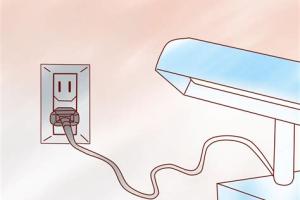Mastering the Basics: A Comprehensive Guide to Wiring a Simple 120v Electrical Circuit

-
Quick Links:
- 1. Introduction
- 2. Understanding 120v Circuits
- 3. Safety First: Essential Precautions
- 4. Tools and Materials You'll Need
- 5. Step-by-Step Guide to Wiring a Simple 120v Circuit
- 6. Common Mistakes to Avoid
- 7. Troubleshooting Tips
- 8. Case Studies: Real-World Applications
- 9. Expert Insights and Additional Resources
- 10. FAQs
1. Introduction
Wiring a simple 120v electrical circuit can seem daunting at first, especially for beginners. However, with the right guidance and knowledge, you can master this essential skill. This comprehensive guide will provide you with everything you need to know about wiring a 120v circuit safely and effectively.
2. Understanding 120v Circuits
Before diving into the wiring process, it’s crucial to understand the basics of 120v electrical circuits. In the U.S., most household circuits operate at 120 volts, primarily for powering lights, outlets, and small appliances.
- Voltage: The electrical potential difference, measured in volts.
- Current: The flow of electrical charge, measured in amperes (amps).
- Resistance: The opposition to current flow, measured in ohms.
3. Safety First: Essential Precautions
Safety should always be your top priority when working with electricity. Here are some essential precautions:
- Always turn off power at the circuit breaker before starting.
- Use insulated tools to prevent electric shocks.
- Wear rubber-soled shoes and avoid working in wet conditions.
- Keep a fire extinguisher nearby and know how to use it.
4. Tools and Materials You'll Need
Before starting your project, gather the following tools and materials:
- Wire cutters/strippers
- Phillips and flathead screwdrivers
- Voltage tester
- Electrical tape
- Wire (appropriate gauge for your circuit)
- Wire nuts
- Outlet or switch (depending on your project)
5. Step-by-Step Guide to Wiring a Simple 120v Circuit
Follow these detailed steps to wire your circuit:
Step 1: Plan Your Circuit
Determine where you will install your outlet or switch. Consider the layout of your room and the location of existing wiring.
Step 2: Turn Off Power
Locate your circuit breaker and turn off the power to the area where you’ll be working. Use a voltage tester to confirm that the power is off.
Step 3: Run the Wiring
Use the appropriate gauge wire for your circuit. For a standard outlet, 14-gauge wire is typically used. Run the wire from the power source to your outlet location, ensuring it is secured properly.
Step 4: Connect the Wires
At your outlet or switch, you will typically find three wires: black (hot), white (neutral), and green or bare (ground). Connect them as follows:
- Black Wire: Connect to the brass terminal.
- White Wire: Connect to the silver terminal.
- Green or Bare Wire: Connect to the green terminal.
Step 5: Secure Everything
Once the wires are connected, carefully push them back into the box and secure the outlet or switch with screws.
Step 6: Restore Power and Test
Return to your circuit breaker and turn the power back on. Use a voltage tester to ensure that everything is functioning correctly.
6. Common Mistakes to Avoid
Even seasoned electricians can make mistakes. Here are common pitfalls to avoid:
- Not turning off the power supply.
- Using the wrong wire gauge.
- Incorrectly connecting wires.
- Neglecting to secure connections properly.
7. Troubleshooting Tips
If your circuit isn’t working as expected, here are some troubleshooting tips:
- Check for loose connections.
- Ensure that the breaker is functioning correctly.
- Use a multimeter to test voltage at various points.
8. Case Studies: Real-World Applications
To illustrate the principles outlined in this guide, let’s examine a few real-life scenarios:
- Case Study 1: A homeowner rewiring their basement for additional outlets.
- Case Study 2: A DIY enthusiast installing a new light fixture.
9. Expert Insights and Additional Resources
For further learning, consider these expert resources:
10. FAQs
What gauge wire should I use for a 120v circuit?
For a typical 15-amp circuit, 14-gauge wire is recommended. For a 20-amp circuit, use 12-gauge wire.
Can I wire a circuit without an electrician?
Yes, as long as you follow safety guidelines and local codes. However, for complex systems, it's best to hire a professional.
What should I do if I see sparks while connecting wires?
Immediately turn off the power and inspect your connections. If unsure, consult a professional electrician.
How do I know if my circuit is overloaded?
If your circuit frequently trips the breaker or outlets feel warm, it may be overloaded. Reduce the number of devices on that circuit.
Is it necessary to ground my circuit?
Yes, grounding is crucial for safety. It prevents electrical shock and fire hazards.
What are the signs of faulty wiring?
Common signs include flickering lights, frequent breaker trips, and strange noises coming from outlets.
How can I ensure my wiring is up to code?
Consult local building codes and regulations. Consider having your work inspected by a certified electrician.
Can I use duct tape instead of electrical tape?
No, duct tape is not designed for electrical applications and can pose a safety hazard.
What is the lifespan of electrical wiring?
Typically, electrical wiring can last 30-40 years, but this can vary based on conditions and use.
What should I do if I accidentally cut the wire?
Turn off the power immediately. Use wire connectors or tape to repair it, or consider replacing the section of wire.
Random Reads
- How to paint a mirror
- How to paint a rusty metal shed
- How to repair a flat roof
- How to repair a faucet that leaks
- Unread outlook messages guide
- Update yahoo contact information
- How to video call between android and iphone
- How to remove shortcut virus
- How to remove scratches from phone screen
- How to turn off windows activation